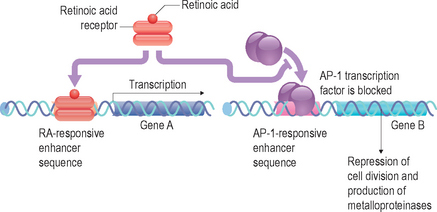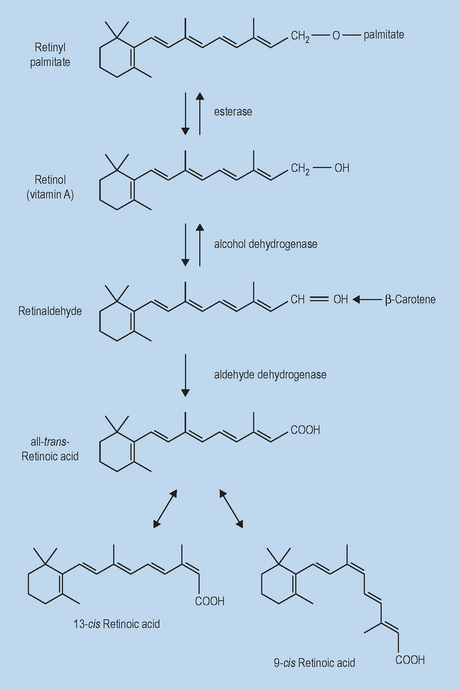Chapter 6 Retinoids
MOLECULAR BIOLOGY OF RETINOIDS
Retinoids are naturally occurring derivatives of beta-carotene and ascribed as vitamin A and its direct metabolites. These include retinol, retinaldehyde, retinyl esters, and retinoic acid (Fig. 6.1). These compounds have an essential role in such processes in higher order mammals as development (including ocular), angiogenesis, and dermatologic homeostasis. One of the key biologically relevant retinoids is retinoic acid, which exists as several isomeric forms (e.g. all-trans, 9-cis and 13-cis) and is essentially an oxidized form of retinol. This molecule has been shown at the molecular level to function as an agonist for the retinoic acid receptors (RAR) and retinoid X receptors (RXR), a specific subgroup from the broader family of nuclear receptors. In this subclass, there exist three isoforms of respective receptors, labeled α, β, and γ. Upon binding of the retinoic acid ligand, RAR and RXR will form a heterodimer that then is capable of interacting with specific DNA sequences located in the promoter regions of retinoid-regulated genes. These nucleic acid sequences are termed retinoic acid response elements (RARE). More recently, it has become apparent that the transcription factor AP-1 also has a significant effect upon regulating activation of genes through its interactions at the RARE site.
In summary, retinoic acid can influence the function of a cell by altering gene expression patterns through its facilitated binding to RAREs of a dimerized RAR/RXR complex (Fig. 6.2). This knowledge of the mechanistic role in retinoid regulation of gene expression patterns allowed for the synthesis of novel pharmacologic classes of compounds that have a broader structural diversity with varying pharmacologic properties than natural retinoids. Additionally, it appears that the majority of biologic effects observed from topical delivery of various retinoids are mediated by interaction through the RAR/RXR complex, including in some cases any obligatory metabolic conversion to retinoic acid.
METABOLISM OF CUTANEOUSLY DELIVERED RETINOIDS
The metabolic pathways that have been identified as involved in retinoid metabolism in the digestive system have been confirmed in large part as existing in human skin (Fig. 6.3). While much of free retinol is esterified via lecithin:retinol acyltransferase (LRAT) or acyl CoA:retinol acyltransferase (ARAT) to retinyl palmitate for storage, a small percentage is further oxidized to the active acid form. The oxidation of free retinol to retinoic acid is the limiting step in the generation of active retinoid metabolites within cells. This process is begun when free retinol associates with a specific cytoplasmic retinol-binding protein (CRBP). The retinol-CRBP complex is a substrate for retinol dehydrogenase, a microsomal enzyme uniquely capable of catalyzing the conversion of retinol to retinaldehyde. Retinaldehyde is then rapidly and quantitatively oxidized to retinoic acid by retinaldehyde oxidase. Once converted, retinoic acid regulates gene expression profiles via RAR/RXR for skin keratinocyte growth and differentiation.
This multistep processing of retinyl esters serves as a point of regulation to control the level of active retinoid in the skin and may thus contribute to the lower irritation potential of these derivatives. Ultimately, retinoic acid can be metabolized irreversibly via hydroxylation to 4-hydroxy-retinoic acid and 4-oxo-retinoic acid via various cytochrome P450. It is important to note that the majority of retinoid metabolism that occurs is mediated via retinoid bound to cytosolic lipid binding proteins. This family of proteins with high retinoid specificity includes CRBP and cytoplasmic retinoic acid-binding protein (CRABP), of which there are two isoforms, I and II.
 irritation that, in some instances, does not mitigate itself completely even after long-term chronic exposure
irritation that, in some instances, does not mitigate itself completely even after long-term chronic exposure
Thus, a significant effort has been expended to identify retinoids that are efficacious and have an overall lower irritation profile and lessened teratogenic safety concerns.











